Additional notes (click to expand)
Medicinal
Culpeper: ‘... hastens travail in women, provokes the Terms. See the Leaves.’ Under Leaves he writes: ‘Dictamny, or Dittany of Creet, ... brings away dead children, hastens womens travail, brings away the afterbirth, the very smell of it drives away venemous beasts, so deadly an enemy is it to poison, it’s an admirable remedy against wounds and Gunshot, wounds made with poisoned weapons, draws out splinters, broken bones etc.
Culpeper, Nicholas. (1650). A Physical Directory . London, Peter Cole.
They say the goats and deers in Creet, being wounded with arrows, eat this herb, which makes the arrows fall out of themselves.
Notes: Dioscorides’ Materia Medica (c. 100 AD), Pliny the Elder’s Natural History and Theophrastus’s Enquiry into Plants all have this information
Culpeper, Nicholas. (1650). A Physical Directory . London, Peter Cole.
Virgil’s Aeneid where he recounts how Venus produced it when her son, Aeneas, had received a deadly wound from an arrow, which fell out on its own when the wound was washed with it (Jashemski).
Jashemski, W F . (1999). A Pompeian Herbal, Ancient and Modern Medicinal Plants. University of Texas Press.
Dioscorides attributes the same property to ‘Tragium’ or ‘Tragion’ which is probably Hypericum hircinum (a St. John’s Wort): ‘Tragium grows in Crete only ... the leaves and the seed and the tear, being laid on with wine doe draw out arrow heads and splinteres and all things fastened within ... They say also that ye wild goats having been shot, and then feeding upon this herb doe cast out ye arrows.’
Gunther, R.T.. (1938). The Greek Herbal of Dioscorides ... Englished by John Goodyear.
Other use
Origanum dictamnus L. Lamiaceae Dittany of Crete, Hop marjoram. Distribution: Crete. Culpeper (1650) writes: ‘... hastens travail [labour] in women, provokes the Terms [menstruation] . See the Leaves.’ Under 'Leaves' he writes: ‘Dictamny, or Dittany of Creet, ... brings away dead children, hastens womens travail, brings away the afterbirth, the very smell of it drives away venemous beasts, so deadly an enemy is it to poison, it’s an admirable remedy against wounds and Gunshot, wounds made with poisoned weapons, draws out splinters, broken bones etc. They say the goats and deers in Creet, being wounded with arrows, eat this herb, which makes the arrows fall out of themselves.' Dioscorides’ Materia Medica (c. 100 AD, trans. Beck, 2005), Pliny the Elder’s Natural History and Theophrastus’s Enquiry into Plants all have this information, as does Vergil’s Aeneid where he recounts how Venus produced it when her son, Aeneas, had received a deadly wound from an arrow, which fell out on its own when the wound was washed with it (Jashemski, 1999). Dioscorides attributes the same property to ‘Tragium’ or ‘Tragion’ which is probably Hypericum hircinum (a St. John’s Wort): ‘Tragium grows in Crete only ... the leaves and the seed and the tear, being laid on with wine doe draw out arrow heads and splinteres and all things fastened within ... They say also that ye wild goats having been shot, and then feeding upon this herb doe cast out ye arrows.’ . It has hairy leaves, in common with many 'vulnaries', and its alleged ability to heal probably has its origin in the ability of platelets to coagulate more easily on the hairs (in the same way that cotton wool is applied to a shaving cut to hasten clotting).
Oakeley, Dr. Henry F. (2013). Wellcome Library notes.
link
Geographical distribution
- Europe, Southeastern Europe, Greece
Origanum dictamnus L.
Family: LAMIACEAEGenus: Origanum
Species: dictamnus L.
Common names: Dittany of Crete
Pharmacopoeia Londinensis name: Dictamnus Cretensis
Distribution summary: Greece (Crete)
Habit: Sub-Shrub
Hardiness: H7 - Very hardy
Habitat: Shady rocks, dry, mountains
Garden status: Currently grown
Garden location: Plants in pots (POT), Classical Europe & Middle East (I)
Flowering months: June, July, August
Reason for growing: Medicinal, other use
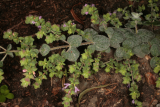
.JPG)
.JPG)
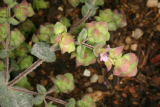
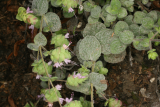

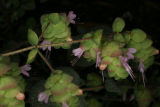
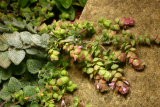
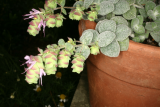
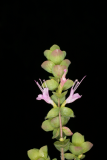
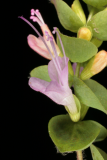
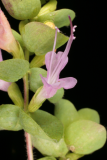
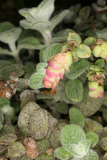
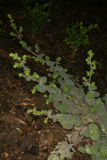
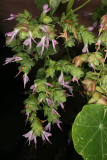
.JPG)
.JPG)
.JPG)